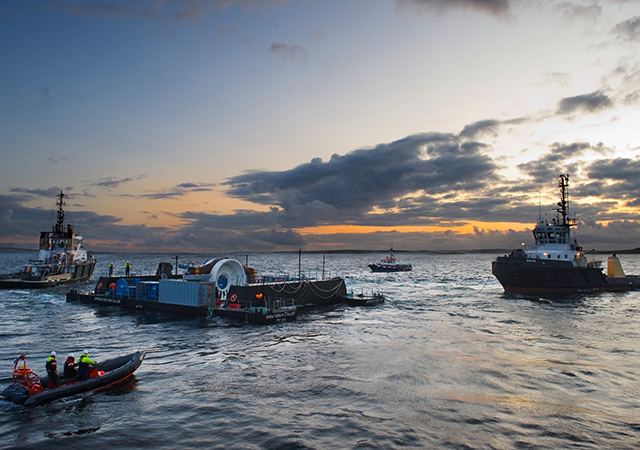
A pioneering EMEC project to produce of green hydrogen via tidal power off Orkney has taken a step forward with the purchase of a special battery to help power it.
The European Marine Energy Centre (EMEC) said the world-first combination of battery and tidal power off the island of Eday will create “continuous green hydrogen”.
Some industry leaders have hailed green hydrogen, produced via renewables, as the “holy grail” of clean energy.
By comparison, blue hydrogen is produced from natural gas, with related emissions being captured and stored.
Developer Invinity Energy Systems, based in Bathgate, said around two-thirds of the Eday scheme’s £1.8m Scottish Government funding was used for the battery and its ancillary components.
The project, expected to go live next year, will use eight Invinity VS3 battery modules to smooth output from the tidal generation, which can be intermittent, to then power EMEC’s hydrogen production plant.
Invinity said the combinination of tidal power, energy storage, and electrolyser technology will produce “large amounts” of hydrogen each year without emitting carbon.
The project involves a 670KW electrolyser and an onshore energy management system on Eday, ready for a tidal developer to test their technology as part of the scheme.
The project is backed by the Scottish Government via Highlands and Islands Enterprise.
Scotland Energy Minister, Paul Wheelhouse, said: “The demonstration of hydrogen and systems integration with renewables will be a key part of our energy transition pathways and we look forward to watching the progress of this exciting and pioneering project, building on the strong track record of Orkney and EMEC, in particular, in demonstrating hydrogen and integrated energy systems.”
Green hydrogen is seen as an important fuel in helping meet climate targets, with ambitions to replace it as a means for certain vehicles, as well as natural gas in the heat system.
A report from ORE Catapult and the Offshore Wind Industries Council (OWIC) earlier tihs year said green hydrogen could be worth £320bn for the UK economy and support 120,000 jobs by 2050.
Neil Kermode, managing director at EMEC, said: “EMEC’s core purpose is to demonstrate technologies in new and inspired ways to decarbonise our energy system. This is the first time that a flow battery will have been coupled with tidal energy and hydrogen production, and will support the development of the innovative energy storage solution being developed in the Interreg NWE ITEG project.
“Following a technical review looking at how to improve the efficiencies of the electrolyser we assessed that flow batteries would be the best fit for the energy system. As flow batteries store electrical charge in a liquid rather than a solid, they can provide industrial quantities of power for a sustained period, can deeply discharge without damaging itself, as well as stand fully charged for extended periods without losing charge. These are all necessary qualities to integrate battery technology with the renewable power generation and hydrogen production process.”
Recommended for you

